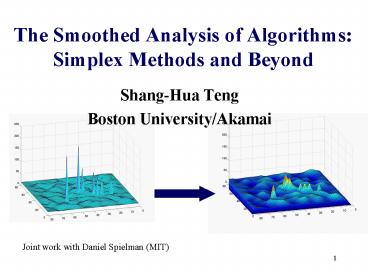The Smoothed Analysis of Algorithms: Simplex Methods and Beyond - PowerPoint PPT Presentation
Title:
The Smoothed Analysis of Algorithms: Simplex Methods and Beyond
Description:
Interpolate between Worst case and Average Case. Consider neighborhood of every input instance ... Avg-Case Analysis (Borgwardt 77, Smale 82, Haimovich, Adler, ... – PowerPoint PPT presentation
Number of Views:43
Avg rating:3.0/5.0
Title: The Smoothed Analysis of Algorithms: Simplex Methods and Beyond
1
The Smoothed Analysis of AlgorithmsSimplex
Methods and Beyond
- Shang-Hua Teng
- Boston University/Akamai
Joint work with Daniel Spielman (MIT)
2
Outline
Why
What
Simplex Method
Numerical Analysis
Condition Numbers/Gaussian Elimination
Conjectures and Open Problems
3
Motivation for Smoothed Analysis
- Wonderful algorithms and heuristics that work
well in practice, but whose performance cannot be
understood through traditional analyses.
worst-case analysis if good, is wonderful.
But, often exponential for these heuristics
examines most contrived inputs average-case
analysis a very special class of inputs
may be good, but is it meaningful?
4
Random is not typical
5
Analyses of Algorithms
worst case maxx T(x) average case Er
T(r) smoothed complexity
6
Instance of smoothed framework
x is Real n-vector sr is Gaussian random
vector, variance s2 measure smoothed
complexity as function of n and s
7
Complexity Landscape
run time
input space
8
Complexity Landscape
worst case
run time
input space
9
Complexity Landscape
worst case
run time
input space
10
Smoothed Complexity Landscape
run time
input space
11
Smoothed Complexity Landscape
run time
smoothed complexity
input space
12
Smoothed Analysis of Algorithms
- Interpolate between Worst case and Average Case.
- Consider neighborhood of every input instance
- If low, have to be unlucky to find bad input
instance
13
Motivating Example Simplex Method for Linear
Programming
max zT x s.t. A x y
- Worst-Case exponential
- Average-Case polynomial
- Widely used in practice
14
The Diet Problem
Minimize 30 x1 80 x2 20 x3 s.t. 30x1
10 x2 6 x3 ? 300 5x1
9x2 8x3 ? 50 1.5x1 2.5 x2
18 x3 ? 70 10x1
6 x3 ? 100
x1, x2, x3 ? 0
15
The Simplex Method
opt
start
16
History of Linear Programming
- Simplex Method (Dantzig, 47)
- Exponential Worst-Case (Klee-Minty 72)
- Avg-Case Analysis (Borgwardt 77, Smale 82,
Haimovich, Adler, Megiddo, Shamir, Karp, Todd) - Ellipsoid Method (Khaciyan, 79)
- Interior-Point Method (Karmarkar, 84)
- Randomized Simplex Method (mO(?d) )
- (Kalai 92, Matousek-Sharir-Welzl
92)
17
Smoothed Analysis of Simplex Method
Spielman-Teng 01
Theorem For all A, simplex method takes
expected time polynomial
18
Shadow Vertices
19
Another shadow
20
Shadow vertex pivot rule
start
z
objective
21
Theorem For every plane, the expected size of
the shadow of the perturbed tope is poly(m,d,1/s )
22
Polar Linear Program
z
max ? ?z Î ConvexHull(a1, a2, ..., am)
23
Initial Simplex
Opt Simplex
24
Shadow vertex pivot rule
25
(No Transcript)
26
Count facets by discretizingto N directions, N ?
27
Count pairs in different facets
So, expect c Facets
28
Expect cone of large angle
29
Intuition for Smoothed Analysis of Simplex
Method
After perturbation, most corners have
angle bounded away from flat
opt
start
most some appropriate measure angle measure by
condition number of defining matrix
30
Condition number at corner
Corner is given by
Condition number is
- sensitivity of x to change in C and b
- distance of C to singular
31
Condition number at corner
Corner is given by
Condition number is
32
Connection to Numerical Analysis
Measure performance of algorithms in terms of
condition number of input
Average-case framework of Smale
1. Bound the running time of an algorithm
solving a problem in terms of its condition
number. 2. Prove it is unlikely that a random
problem instance has large condition number.
33
Connection to Numerical Analysis
Measure performance of algorithms in terms of
condition number of input
Smoothed Suggestion
1. Bound the running time of an algorithm
solving a problem in terms of its condition
number. 2. Prove it is unlikely that a
perturbed problem instance has large
condition number.
34
Condition Number
Theorem for Gaussian random matrix
variance centered anywhere
Sankar-Spielman-Teng 02
35
Condition Number
Theorem for Gaussian random matrix
variance centered anywhere
(conjecture)
Sankar-Spielman-Teng 02
36
Gaussian Elimination
- A LU
- Growth factor
- With partial pivoting, can be 2n
- Precision needed ? (n ) bits
- For every A,
37
Condition Number and Iterative LP Solvers
Renegar defined condition number for LP
maximize subject to
- distance of (A, b, c) to ill-posed linear
program - related to sensitivity of x to change in (A,b,c)
Number of iterations of many LP solvers
bounded by function of condition number
Ellipsoid, Perceptron, Interior Point, von Neumann
38
Smoothed Analysis of Perceptron Algorithm
Blum-Dunagan 01
Theorem For perceptron algorithm
Bound through wiggle room, a condition
number
Note slightly weaker than a bound on expectation
39
Smoothed Analysis of Renegars Cond Number
Theorem
Dunagan-Spielman-Teng 02
Corollary smoothed complexity of interior
point method is for accuracy e
40
Perturbations of Structured and Sparse Problems
Structured perturbations of structured inputs
perturb
Zero-preserving perturbations of sparse inputs
perturb non-zero entries
Or, perturb discrete structure
41
Goals of Smoothed Analysis
Relax worst-case analysis Maintain mathematical
rigor Provide plausible explanation for
practical behavior of algorithms Develop a
theory closer to practice
http//math.mit.edu/spielman/SmoothedAnalysis
42
(No Transcript)
43
(union bound)
44
Lemma
So
45
Smoothed Analysis of Renegars Cond Number
Theorem
Dunagan-Spielman-Teng 02
Corollary smoothed complexity of interior
point method is for accuracy e
conjecture






![Chapter 3: Simplex methods [Big M method and special cases] PowerPoint PPT Presentation](https://s3.amazonaws.com/images.powershow.com/4471558.th0.jpg?_=202101090310)
























